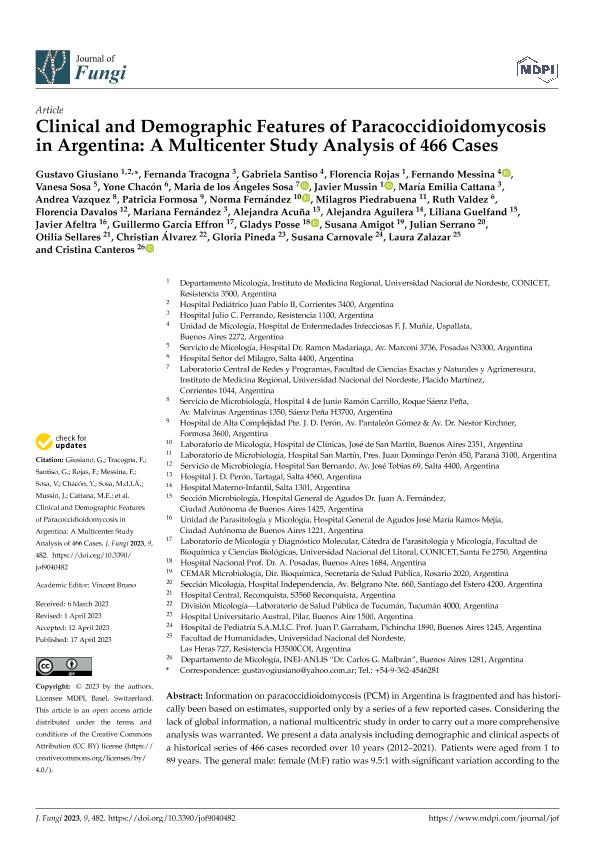Artículo
Clinical and Demographic Features of Paracoccidioidomycosis in Argentina: A Multicenter Study Analysis of 466 Cases
Giusiano, Gustavo Emilio ; Tracogna, Maria Fernanda; Santiso, Gabriela Maria; Rojas, Florencia Dinorah
; Tracogna, Maria Fernanda; Santiso, Gabriela Maria; Rojas, Florencia Dinorah ; Messina, Fernando; Sosa, Vanesa; Chacón, Yone; Sosa, Maria de los Ángeles; Mussin, Javier Esteban
; Messina, Fernando; Sosa, Vanesa; Chacón, Yone; Sosa, Maria de los Ángeles; Mussin, Javier Esteban ; Cattana, María Emilia; Vazquez, Andrea; Formosa, Patricia; Fernández, Norma; Piedrabuena, Milagros; Valdez, Ruth; Davalos, Florencia; Fernández, Mariana; Acuña, Alejandra; Aguilera, Alejandra; Guelfand, Liliana; Afeltra, Javier; Garcia Effron, Guillermo; Posse, Gladys; Amigot, Susana; Serrano, Julian; Sellares, Otilia; Álvarez, Christian; Pineda, Gloria; Carnovale, Susana; Zalazar, Laura; Canteros, Cristina Elena
; Cattana, María Emilia; Vazquez, Andrea; Formosa, Patricia; Fernández, Norma; Piedrabuena, Milagros; Valdez, Ruth; Davalos, Florencia; Fernández, Mariana; Acuña, Alejandra; Aguilera, Alejandra; Guelfand, Liliana; Afeltra, Javier; Garcia Effron, Guillermo; Posse, Gladys; Amigot, Susana; Serrano, Julian; Sellares, Otilia; Álvarez, Christian; Pineda, Gloria; Carnovale, Susana; Zalazar, Laura; Canteros, Cristina Elena
 ; Tracogna, Maria Fernanda; Santiso, Gabriela Maria; Rojas, Florencia Dinorah
; Tracogna, Maria Fernanda; Santiso, Gabriela Maria; Rojas, Florencia Dinorah ; Messina, Fernando; Sosa, Vanesa; Chacón, Yone; Sosa, Maria de los Ángeles; Mussin, Javier Esteban
; Messina, Fernando; Sosa, Vanesa; Chacón, Yone; Sosa, Maria de los Ángeles; Mussin, Javier Esteban ; Cattana, María Emilia; Vazquez, Andrea; Formosa, Patricia; Fernández, Norma; Piedrabuena, Milagros; Valdez, Ruth; Davalos, Florencia; Fernández, Mariana; Acuña, Alejandra; Aguilera, Alejandra; Guelfand, Liliana; Afeltra, Javier; Garcia Effron, Guillermo; Posse, Gladys; Amigot, Susana; Serrano, Julian; Sellares, Otilia; Álvarez, Christian; Pineda, Gloria; Carnovale, Susana; Zalazar, Laura; Canteros, Cristina Elena
; Cattana, María Emilia; Vazquez, Andrea; Formosa, Patricia; Fernández, Norma; Piedrabuena, Milagros; Valdez, Ruth; Davalos, Florencia; Fernández, Mariana; Acuña, Alejandra; Aguilera, Alejandra; Guelfand, Liliana; Afeltra, Javier; Garcia Effron, Guillermo; Posse, Gladys; Amigot, Susana; Serrano, Julian; Sellares, Otilia; Álvarez, Christian; Pineda, Gloria; Carnovale, Susana; Zalazar, Laura; Canteros, Cristina Elena
Fecha de publicación:
04/2023
Editorial:
MDPI
Revista:
Journal of Fungi
ISSN:
2309-608X
Idioma:
Inglés
Tipo de recurso:
Artículo publicado
Clasificación temática:
Resumen
Information on paracoccidioidomycosis (PCM) in Argentina is fragmented and has historically been based on estimates, supported only by a series of a few reported cases. Considering the lack of global information, a national multicentric study in order to carry out a more comprehensive analysis was warranted. We present a data analysis including demographic and clinical aspects of a historical series of 466 cases recorded over 10 years (2012–2021). Patients were aged from 1 to 89 years. The general male: female (M:F) ratio was 9.5:1 with significant variation according to the age group. Interestingly, the age range 21–30 shows an M:F ratio of 2:1. Most of the cases (86%) were registered in northeast Argentina (NEA), showing hyperendemic areas in Chaco province with more than 2 cases per 10,000 inhabitants. The chronic clinical form occurred in 85.6% of cases and the acute/subacute form occurred in 14.4% of cases, but most of these juvenile type cases occurred in northwestern Argentina (NWA). In NEA, the incidence of the chronic form was 90.6%; in NWA, the acute/subacute form exceeded 37%. Diagnosis by microscopy showed 96% positivity but antibody detection displays 17% of false negatives. Tuberculosis was the most frequent comorbidity, but a diverse spectrum of bacterial, fungal, viral, parasitic, and other non-infectious comorbidities was recorded. This national multicenter registry was launched in order to better understand the current status of PCM in Argentina and shows the two endemic zones with a highly diverse epidemiology.
Palabras clave:
ARGENTINA
,
CLINICAL
,
DEMOGRAPHIC
,
DIAGNOSIS
,
EPIDEMIOLOGY
,
PARACOCCIDIOIDOMYCOSIS
Archivos asociados
Licencia
Identificadores
Colecciones
Articulos(CCT - NORDESTE)
Articulos de CTRO.CIENTIFICO TECNOL.CONICET - NORDESTE
Articulos de CTRO.CIENTIFICO TECNOL.CONICET - NORDESTE
Citación
Giusiano, Gustavo Emilio; Tracogna, Maria Fernanda; Santiso, Gabriela Maria; Rojas, Florencia Dinorah; Messina, Fernando; et al.; Clinical and Demographic Features of Paracoccidioidomycosis in Argentina: A Multicenter Study Analysis of 466 Cases; MDPI; Journal of Fungi; 9; 4; 4-2023; 1-15
Compartir
Altmétricas



